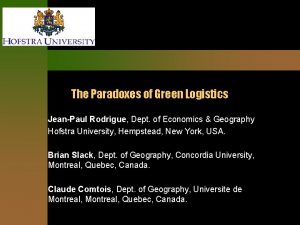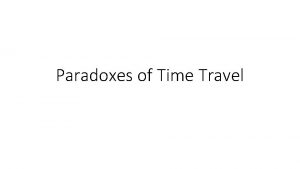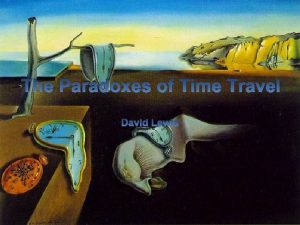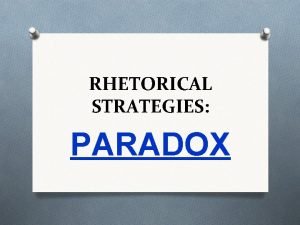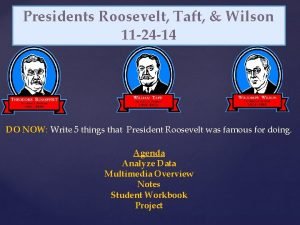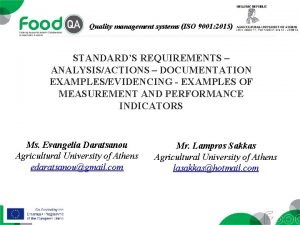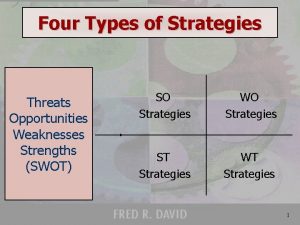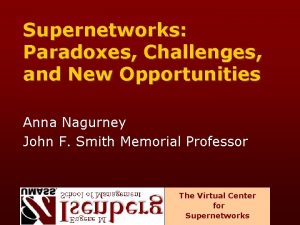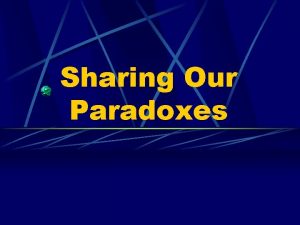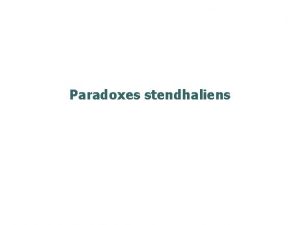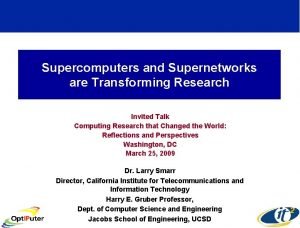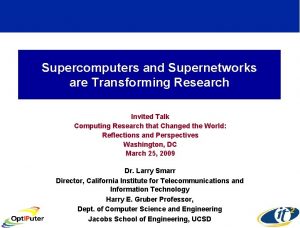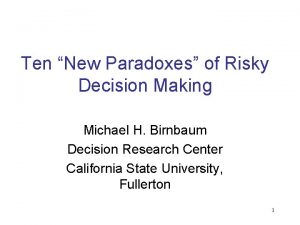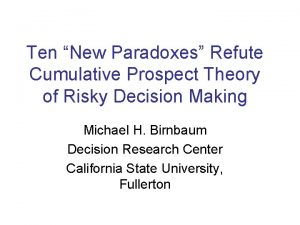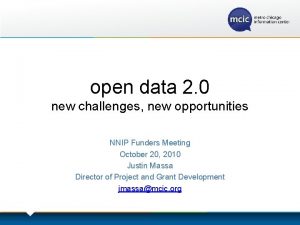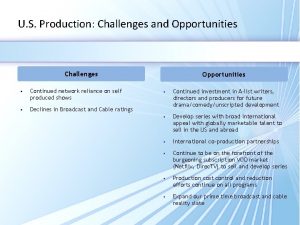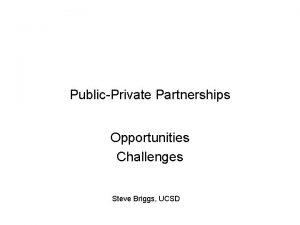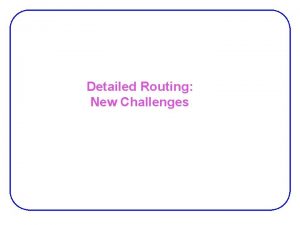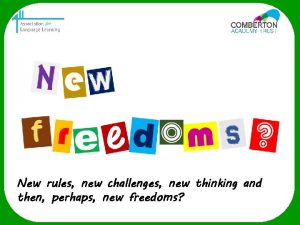Supernetworks Paradoxes Challenges and New Opportunities Anna Nagurney



























- Slides: 27

Supernetworks: Paradoxes, Challenges, and New Opportunities Anna Nagurney John F. Smith Memorial Professor The Virtual Center for Supernetworks

Funding provided by: AT&T Foundation National Science Foundation John F. Smith Memorial Fund - University of Massachusetts at Amherst.

Throughout history, networks have served as the foundation for connecting humans to one another and their activities. • Roads were laid, bridges built, and waterways crossed so that humans, be they on foot, on animal, or vehicle could traverse physical distance through transportation. The airways were conquered through flight. • Communications were conducted using the available means of the period, from smoke signals, drum beats, and pigeons, to the telegraph, telephone, and computer networks of today.

Importance of Networks to the Economy • US consumers, businesses, and governments spent $950 billion on transportation in 1998 (US DOT). • Corporate buyers spent $517. 6 billion on telecommunications in 1999 (Purchasing). • Energy expenditures in the United States were $515. 8 billion in 1995 (US Dept. of Commerce).

Information technology has transformed the ways in which individuals work, travel, and conduct their daily activities, with profound implications for existing and future networks. The decision-making process itself has been altered due to the addition of alternatives and options which were not possible or even feasible. The boundaries for decision-making have been redrawn as individuals can now work from home or purchase products from work.

We live in an era in which the freedom to choose is weighted by the immensity of choices and possibilities: • Where should one live? • Where should one work? And when? • How should one travel? Or communicate? And with whom? • Where should one shop? And how?

Classical Networks

Supernetworks: A New Paradigm

Reality of Today's Networks: • large-scale nature and complexity of network topology; • congestion; • alternative behavior of users of the network, which may lead to paradoxical phenomena; • the interactions among networks themselves such as in transportation versus telecommunications networks; • policies surrounding networks today may have a major impact not only economically but also socially.

Large-Scale Nature and Complexity • Chicago's Regional Transportation Network has 12, 982 nodes, 39, 018 links, and 2, 297, 945 origin/destination pairs. • AT&T's domestic network has 100, 000 origin/destination pairs. In the detail graph applications in which nodes are phone numbers and edges are calls, there are 300 million nodes and 4 billion edges.

Congestion • In the case of transportation networks in the United States alone, congestion results in $100 billion in lost productivity, whereas the figure in Europe is estimated to be $150 billion. • In terms of the Internet, the FCC reports that the volume of traffic is doubling every 100 days, which is remarkable given that telephone traffic has typically increased only by about 5 percent a year.

System-Optimization versus User-Optimization In transportation networks, travelers select their routes of travel from an origin to a destination so as to minimize their own travel cost or travel time, which although optimal from an individual's perspective (useroptimization) may not be optimal from a societal one (system-optimization) where one has control over the flows on the network.

The Braess’ Paradox Assume a network with a single O/D pair (1, 4). There are 2 paths available to travelers: p 1=(a, c) and p 2=(b, d). For a travel demand of 6, the equilibrium path flows are xp 1* = xp 2* = 3 and The equilibrium path travel cost is Cp 1= Cp 2= 83. 1 a b 2 3 c d 4 ca(fa)=10 fa cb(fb) = 10 fb+50 cc(fc) = fc+50 cd(fd) = 10 fd

Adding a Link Increased Travel Cost for All! Adding a new link creates a new path p 3=(a, e, d). The original flow distribution pattern is no longer an equilibrium pattern, since at this level of flow the cost on path p 3, Cp 3=70. The new equilibrium flow pattern network is xp 1* = xp 2* = xp 3*=2. The equilibrium path travel costs: Cp 1 = Cp 2 = Cp 3 = 92. 1 a b e 2 3 c d 4

This phenomenon is also relevant to telecommunications networks and, in particular, to the Internet which is another example of a noncooperative network.

Recently, we have discovered paradoxes in networks with zero emission links such as telecommmunication networks: • The addition of a zero emission link may result in an increase in total emissions with no change in demand! • A decrease in demand on a network with a zero emission link may result in an increase in total emissions!

One must incorporate the network topology, the relevant cost and demand structure, as well as the behavior of the users of the transportation/telecommunication network into any network-based policy! These paradoxes further illustrate the interconnectivity among distinct network systems and that they cannot be studied simply in isolation.

Supernetworks • Supernetworks may be comprised of such networks as transportation, telecommunication, logistical, and/or financial networks. • They may be multilevel as when they formalize the study of supply chain networks or multitiered as in the case of financial networks with intermediation. • Decision-makers may be faced with multiple criteria; thus, the study of supernetworks also includes the study of multicriteria decision-making.

Applications of Supernetworks • Telecommuting/Commuting Decision-Making • Teleshopping/Shopping Decision. Making • Supply Chain Networks with Electronic Commerce • Financial Networks with Electronic Transactions.

A Supernetwork Conceptualization of Commuting versus Telecommuting

A Supernetwork Framework for Teleshopping versus Shopping

The Supernetwork Structure of a Supply Chain Network


International Financial Networks with Electronic Transactions

Summary and Conclusions We have described the realities surrounding networks today and the challenges and complexities posed for their analysis and study. We have argued for new paradigms to capture decision-making in the Information Age. We have focused on the concept of supernetworks and have discussed a variety of applications.

The advances in Information Technologies have enabled not only new connections and applications but have allowed for the implementation of powerful analytical methodologies for the solution of complex network problems which underlie our economies and societies today.

Thank you! For more information, see http: //supernet. som. umass. edu The Virtual Center for Supernetworks
 Two households both alike in dignity
Two households both alike in dignity The opportunities of media and information
The opportunities of media and information Paradoxes of green logistics
Paradoxes of green logistics Insidious definition fahrenheit 451
Insidious definition fahrenheit 451 David lewis the paradoxes of time travel
David lewis the paradoxes of time travel The paradoxes of time travel david lewis
The paradoxes of time travel david lewis Paradoxes
Paradoxes Imperative definition literature
Imperative definition literature Consonance definition figurative language
Consonance definition figurative language Greater bay area opportunities and challenges
Greater bay area opportunities and challenges Generation of a new entry opportunity
Generation of a new entry opportunity The new nation faces challenges
The new nation faces challenges New york pennsylvania new jersey delaware
New york pennsylvania new jersey delaware Fresh oil new wine
Fresh oil new wine Both new hampshire and new york desire more territory
Both new hampshire and new york desire more territory The actual and potential rival offerings and substitutes
The actual and potential rival offerings and substitutes New classical and new keynesian macroeconomics
New classical and new keynesian macroeconomics Chapter 16 toward a new heaven and a new earth
Chapter 16 toward a new heaven and a new earth Both new hampshire and new york desire more territory
Both new hampshire and new york desire more territory New classical and new keynesian macroeconomics
New classical and new keynesian macroeconomics Punctuating split speech
Punctuating split speech Marquee theater new hartford
Marquee theater new hartford New-old approach to creating new ventures
New-old approach to creating new ventures Njbta
Njbta Roosevelt vs taft venn diagram
Roosevelt vs taft venn diagram Actions to address risks and opportunities
Actions to address risks and opportunities Swot wo
Swot wo Industry types and the opportunities they offer
Industry types and the opportunities they offer


